Guide to Big Island Snorkeling Tours
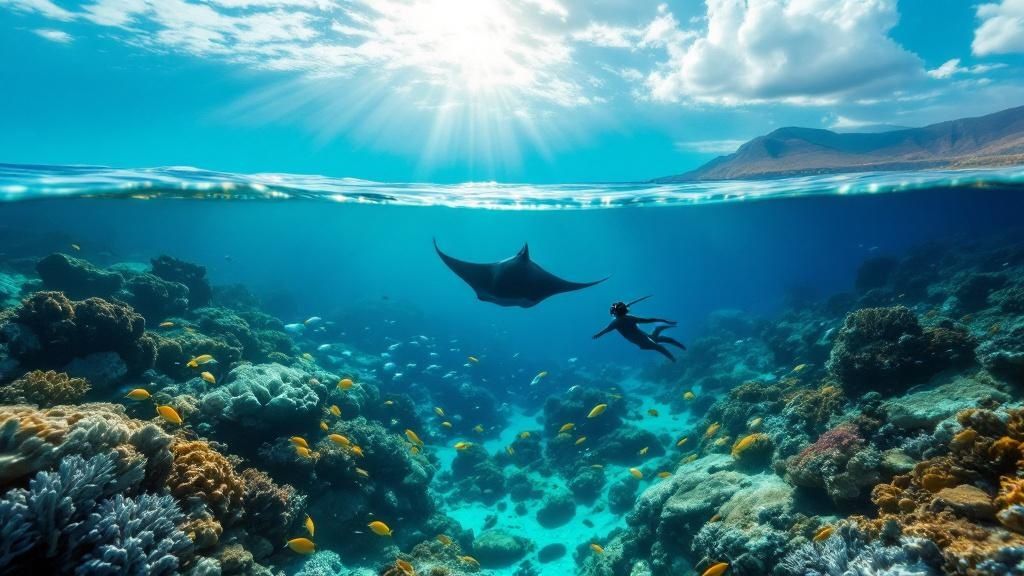
Close your eyes and picture Hawaii. Chances are, you’re imagining yourself floating effortlessly in warm, turquoise water, with schools of impossibly colorful fish darting around ancient coral reefs. On the Big Island, that vision is very much a reality. Taking a snorkeling tour here, especially along the sun-drenched Kona coast, is like diving headfirst into that daydream.
It’s no exaggeration to say this area is a world-class underwater paradise. As the top-rated and most-reviewed snorkel company in Hawaii, Kona Snorkel Trips has had the privilege of showing thousands of guests this incredible underwater world.
Why Kona Offers Hawaii's Best Snorkeling
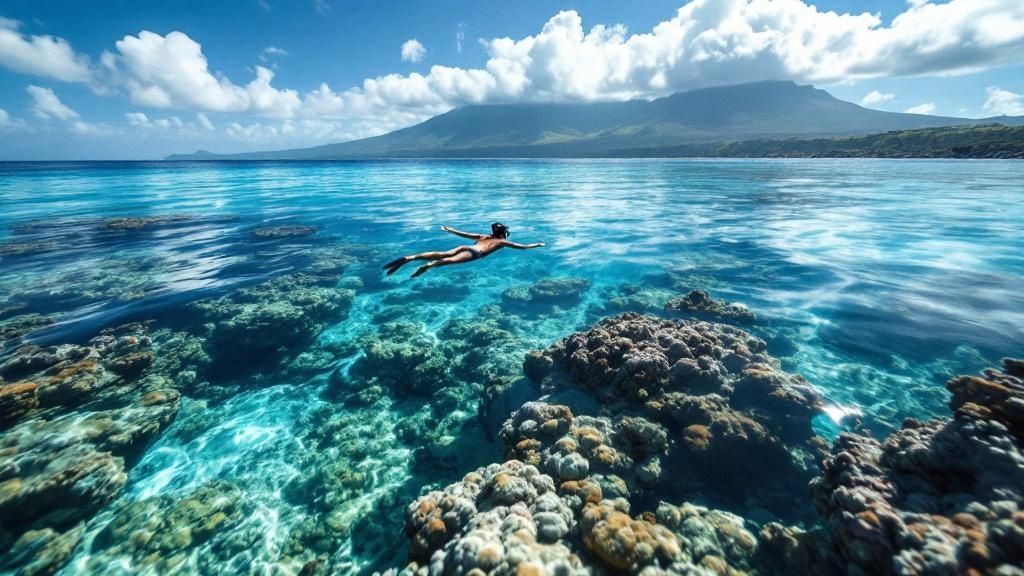
So, what’s Kona’s secret? It really comes down to geography. The sheer size of the Mauna Loa and Hualalai volcanoes creates a massive natural shield, blocking the powerful trade winds that batter other parts of the island. The result is consistently calm, clear, and protected water—the perfect conditions for exploring the world just beneath the surface.
This unique setup has allowed a breathtaking marine ecosystem to thrive. The coastline is a stunning mosaic of vibrant coral gardens, dramatic underwater lava arches, and quiet, sheltered coves that are just teeming with life. When you join a tour here, you're doing so much more than just going for a swim. You're immersing yourself in a true aquatic wonderland.
What Makes Kona's Marine Life So Special
The diversity of life you can see on a single trip is just incredible. One minute, you might be watching iconic Hawaiian green sea turtles (honu) resting peacefully on the ocean floor; the next, you could see a pod of playful spinner dolphins leaping through the boat's wake. This is exactly why picking the right guide is so crucial to your experience.
With a top-rated company, you’re not just getting a boat ride. You’re getting a safe, educational, and unforgettable adventure led by local experts who live and breathe these waters. It's no accident that Kona Snorkel Trips is known as Hawaii's top-rated and most-reviewed snorkel company—that reputation was earned by consistently delivering amazing experiences.
Your Adventure Awaits
One of the best things about Kona is the sheer variety of tours available. Whether you're a history enthusiast, an adrenaline seeker, or a family looking for a relaxing day on the water, there’s a perfect trip for you.
Here's a quick look at some of the top-tier snorkeling experiences and what makes them a must-do.
Big Island Snorkeling Tours at a Glance
| Snorkel Tour | Perfect For | Unique Highlight |
|---|---|---|
| Historic Kealakekua Bay | History lovers & families | Crystal-clear water at a protected marine sanctuary where Captain Cook first landed. |
| Manta Ray Night Snorkel | Bucket-list adventurers | Floating above majestic manta rays as they gracefully feed on plankton at night. |
| Coastal Exploration | Thrill-seekers & explorers | Discovering hidden sea caves and ancient lava tubes along the volcanic coastline. |
Each of these tours opens up a different window into the incredible biodiversity of the Big Island. This guide will walk you through the absolute best Big Island snorkeling tours to help you find the underwater adventure that’s a perfect fit for your Hawaiian vacation.
Snorkeling the Historic Kealakekua Bay
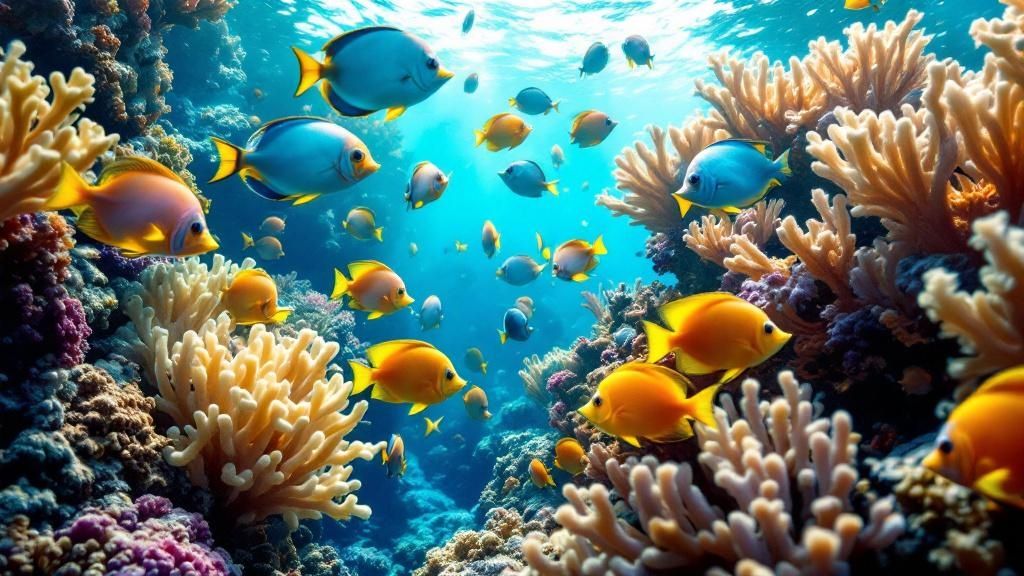
There are some places on Earth that just feel special—almost sacred. Kealakekua Bay is one of them. Tucked away on the South Kona coast, this bay is far more than just a pretty spot to snorkel; it's a place where history feels alive. As your boat glides into its calm waters, you can’t miss the stark white obelisk of the Captain Cook Monument, marking the spot where the British explorer first made contact with Hawaiians in 1779.
But the history here goes much deeper than that single monument. The entire bay is a state historical park and, crucially for snorkelers, a Marine Life Conservation District. This protection has allowed the underwater world to blossom into one of the most incredible snorkeling sites in all of Hawaii. Think of it as a giant, natural aquarium where the water is unbelievably clear—with visibility often reaching over 100 feet—and shielded from the open ocean's wind and swell. That’s Kealakekua.
A Vibrant Underwater World Awaits
The moment you slip into the water, you get it. You understand why people rave about this place. The bay is filled with sprawling coral gardens that slope gently from the shoreline, creating a complex and thriving habitat for an almost overwhelming amount of marine life.
It's a genuine underwater paradise where you're likely to encounter:
- Vast Coral Reefs: We're talking about healthy, vibrant coral formations stretching in every direction, forming the foundation for this entire ecosystem.
- Schools of Tropical Fish: Get ready for a kaleidoscope of color. Hundreds of yellow tangs, butterflyfish, and parrotfish dart all around you.
- Playful Spinner Dolphins: It’s not at all unusual for pods of spinner dolphins to visit the bay. Seeing them leap and play in the boat’s wake is a memory you won’t soon forget.
The sheer abundance and variety of life here are what make Kealakekua a must-do on any list of Big Island snorkeling tours. You aren't just swimming; you're immersing yourself in a protected, flourishing world.
Because Kealakekua Bay is a protected area, the marine life has been able to thrive without interference. This means you’ll see healthier corals and a greater diversity of fish than at many other easily accessible snorkel spots.
The Best Way to Explore the Bay
So, how do you get to this amazing spot? Because of its protected status and the rugged coastline, reaching the prime snorkeling area near the monument on your own is tough. By far, the best and most rewarding way to experience the bay is on a guided boat tour. A good tour takes care of all the details, from providing high-quality snorkel gear to sharing fascinating stories about the area's history and geology. Our Captain Cook snorkeling tour is one of the best ways to experience it.
For a comprehensive look at what makes this specific adventure so unforgettable, be sure to read our complete guide to the Kealakekua Bay snorkeling tour experience. It gives you an even closer look at what to expect on this incredible trip.
Experiencing the Manta Ray Night Snorkel
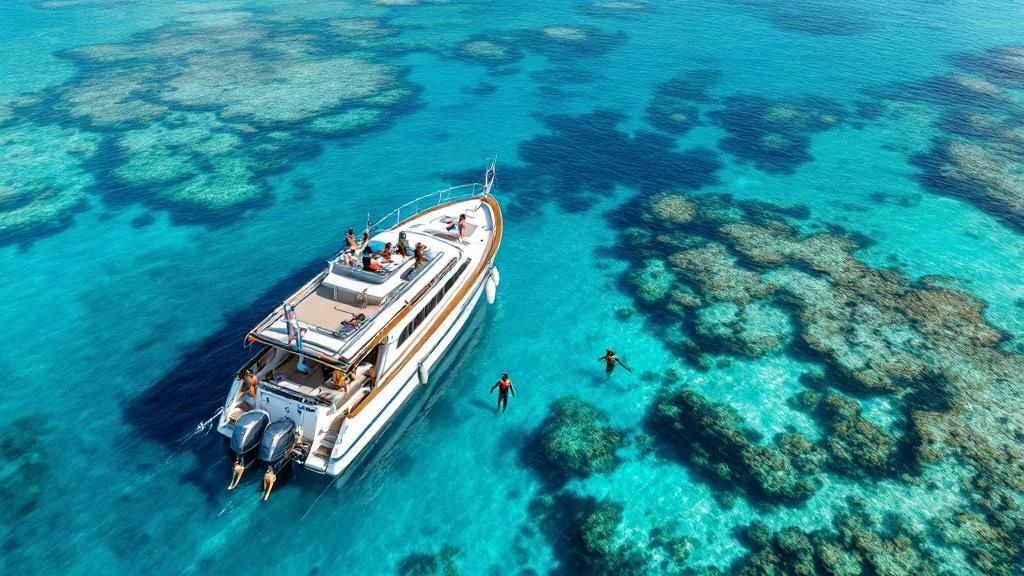
Some travel experiences are fun, but others stick with you for a lifetime. The manta ray night snorkel is definitely one of those moments that changes how you see the ocean. It's such a unique adventure that it's put the Kona coast on the map for anyone seeking a truly special wildlife encounter. For many, it's not just another one of the Big Island snorkeling tours—it's the reason they came to Hawaii.
The whole thing feels like a dream. Just as the sun dips below the horizon, you’ll head out on a boat to a spot known for manta ray gatherings. You then slip into the calm, dark water, holding onto a custom-built light board. The world above the surface melts away, and all you see is the beautiful blue glow lighting up the ocean beneath you.
And then, the show begins.
How It All Works
What unfolds next is a brilliant, yet simple, chain of events rooted in biology. The powerful, eco-friendly lights on your board attract massive clouds of microscopic plankton, which are the very foundation of the ocean’s food chain. This essentially creates a glowing, all-you-can-eat buffet in the middle of the dark ocean.
Manta rays, being filter feeders, can't resist this concentrated feast. They glide in silently from the darkness, like huge, graceful shadows. The result is an underwater ballet, and you have the best seat in the house. You just float on the surface while these gentle giants, some with wingspans over 15 feet, perform an aquatic dance just inches below you.
They swoop, glide, and do breathtaking barrel rolls, their giant mouths wide open to filter the plankton from the water. It’s a powerful, humbling, and completely safe encounter.
What Makes This Encounter So Special
Unlike a lot of wildlife tours where you might just catch a quick glimpse of an animal from a distance, the manta ray night snorkel is consistently up-close and personal. You aren't just a spectator; you're part of the scene.
The best part? It's completely passive for you. Your only job is to float, watch, and let yourself be amazed. The mantas are wild animals, free to come and go. The tour simply sets the stage for a natural feeding event, allowing for respectful, close-up observation.
The Big Island’s Kona coast is known worldwide as the most reliable place to see manta rays at night. This has turned into a flagship adventure for the island, drawing people from all over who want to witness these gentle giants feed under the lights. It's a huge part of the local tourism scene, all built around this one-of-a-kind marine spectacle.
Choosing an Ethical and Safe Tour
Because this experience brings you so close to a protected species, picking the right tour operator is incredibly important. A reputable company like Kona Snorkel Trips follows the Manta Ray Green List standards, which are all about keeping both the mantas and the snorkelers safe.
Their guides give a fantastic briefing before you even get in the water, explaining manta ray behavior and the dos and don'ts of respectful interaction. To get a better feel for what makes this adventure so incredible, you can read our detailed guide to the Kona manta ray night snorkel experience.
Choosing the Right Snorkel Tour For You
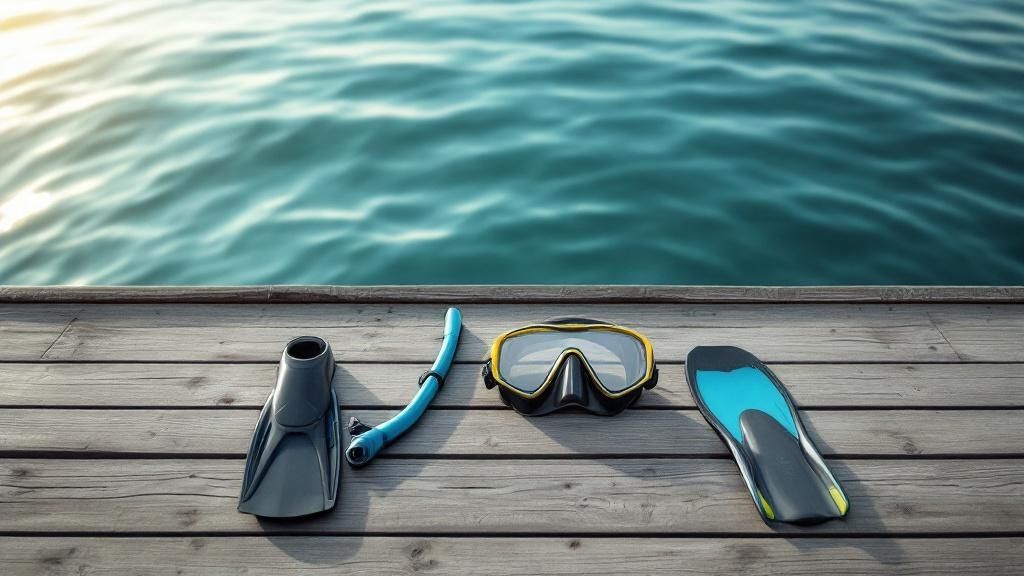
With so many incredible options, picking from the lineup of Big Island snorkeling tours can feel like the toughest decision of your vacation. But it doesn't have to be. The secret is simply matching the tour to your comfort level, your group’s needs, and what you’re hoping to see and do.
Here at Kona Snorkel Trips, we've built our reputation as Hawaii's top-rated and most-reviewed snorkel company by making that choice easy. We handle all the details so you can focus on one thing: having an amazing time. Every trip includes top-notch, sanitized snorkel gear, prescription masks if you need them, and flotation devices like pool noodles and vests for total peace of mind in the water. Of course, we also provide plenty of refreshing snacks and drinks to keep you going.
Our lifeguard-certified guides are right there in the water with you, offering tips, pointing out hard-to-spot marine life, and making sure everyone feels safe and confident. It’s that level of hands-on care that turns a good day into an unforgettable one. When you're looking at different operators, consider the level of guidance they offer, similar to what you'd find in professional diving and water sports courses, to make sure you're in good hands.
Choosing Your Vessel
The type of boat you're on can make a huge difference in your day. That's why we have different vessels designed for different adventures. For our Captain Cook and coastal tours, you’ll likely find yourself on the Nai'a, our spacious 40-foot custom-built boat.
The Nai'a is all about providing a smooth, stable ride. We designed it for pure comfort.
- Plenty of Space: You'll have lots of room to stretch out and move around, never feeling cramped.
- Onboard Restroom: A clean and convenient marine head is available for your comfort throughout the trip.
- Easy Water Access: Getting into and out of the ocean is a breeze thanks to two large swim steps and sturdy ladders, perfect for all ages and mobility levels.
- Shaded Seating: A large canopy provides a welcome retreat from the warm Hawaiian sun whenever you need a break.
This boat is an ideal choice for families, first-time snorkelers, or anyone who simply appreciates a comfortable and relaxing day on the water.
Morning vs. Afternoon Tours: What's the Difference?
Another question we get all the time is whether to book a morning or an afternoon trip. Honestly, both offer fantastic snorkeling, but they each have a different vibe.
Morning Tours (Typically 8:00 AM – 12:00 PM):
- Pros: The ocean is usually at its absolute calmest, with glassy conditions and incredible visibility. The sun is a bit gentler, and you get your adventure in early, leaving your afternoon wide open.
- Cons: You do have to get an earlier start to your day.
Afternoon Tours (Typically 12:30 PM – 4:30 PM):
- Pros: This is perfect for those who prefer a more relaxed start to their vacation day. The marine life is still very active, and you get to enjoy a beautiful sunny afternoon out on the Kona coast.
- Cons: Afternoon trade winds can sometimes kick up, which might make the water a little choppier than in the morning.
Our Pro Tip: If you want the absolute best water conditions—we're talking crystal-clear, calm, and magical—we almost always suggest a morning tour. That said, if you're not an early riser, an afternoon trip is still a phenomenal way to explore Kona's underwater world.
Ultimately, the best Big Island snorkeling tour is the one that fits your schedule and style. With a little bit of planning, you can make sure your day on the water is everything you dreamed of and more.
How to Snorkel Sustainably in Hawaii
When you dip below the surface on a Big Island snorkeling tour, you're not just entering the water—you're stepping into a living, breathing, and incredibly fragile world. Protecting this underwater paradise is a shared responsibility, or kuleana, as it's known in Hawaii. The good news is that it’s easy to do your part. By being mindful, you can help ensure these reefs stay vibrant for years to come.
Sustainable snorkeling starts before your toes even hit the water. It all begins with your sunscreen. Many popular sunscreens are loaded with chemicals like oxybenzone and octinoxate, which are devastating to coral reefs and have even been banned for sale in Hawaii.
The solution is simple: stick to reef-safe sunscreen. Look for mineral-based formulas that use zinc oxide or titanium dioxide. To make sure it works for you and the reef, slather it on at least 20-30 minutes before you plan to get wet. This gives it time to sink in and do its job. It’s a small change that makes a massive difference.
The Golden Rule of Snorkeling
Once you’re in the water, the most important rule is the easiest to remember: look, but don’t touch. It’s tempting to get up close, but those coral formations that look like rugged rocks are actually colonies of thousands of tiny, delicate animals called polyps.
Just brushing against coral with your hand or fin can scrape off its protective slime coat, leaving it open to disease and infection. Standing on it, even for a second, can destroy growth that took decades to form. The best approach is to simply float, watch, and keep a respectful distance from the reef.
This "hands-off" policy applies to all marine life, too. It’s an incredible feeling to swim near a sea turtle or a pod of dolphins, but remember you’re a guest in their home. Chasing or trying to touch wildlife stresses them out and interrupts crucial behaviors like feeding and resting. Give them space—it's the ultimate sign of respect.
Embrace Responsible Tourism
Your personal choices are a powerful part of a much bigger conservation movement. The Big Island is a leader in sustainable tourism, and that directly shapes how Big Island snorkeling tours and other activities are managed to protect the ocean. For example, Hawaii has introduced a 'green fee,' a climate-focused tax on overnight visitors, to help fund conservation. In turn, tour operators are stepping up, earning eco-certifications and educating their guests on how to be better stewards of the sea. You can discover more about how Hawaii is leading sustainable tourism trends.
This is why choosing the right tour operator matters so much. Here at Kona Snorkel Trips, protecting the ocean is woven into everything we do.
- Education First: Our guides are passionate about the ocean. They won’t just point out a cool fish; they’ll explain why the reef is so important and how we can all help protect it.
- Eco-Friendly Practices: We provide reef-safe sunscreen on every tour and follow strict, science-backed guidelines for all our wildlife encounters.
- Community Leadership: We’re not just a business; we’re part of the local community. We actively support conservation efforts and lead by example on every trip.
When you book a tour with a company that puts the ocean first, you become an active partner in preserving Hawaii’s natural wonders. Snorkeling responsibly means the magic you witness today will still be here for future generations to discover.
Of course. Here is the rewritten section, designed to sound natural and human-written, as if from an experienced guide.
Essential Tips for a Perfect Snorkel Day
Getting ready for an amazing day on the water is about more than just showing up. A little bit of planning can honestly turn a good trip into an unforgettable one. By packing a few key items and knowing a couple of simple tricks, you can make sure your Big Island snorkeling tour is comfortable, fun, and totally stress-free.
Your Simple Packing Checklist
We’ve got you covered with all the snorkel gear, snacks, and drinks you'll need, but bringing a small day bag with your own stuff will make the experience even better. Think of it as your personal comfort kit for a day out at sea.
Here’s what I always tell our guests to bring:
- A Towel: Essential for drying off and staying cozy after your swim.
- Reef-Safe Sunscreen: This is a big one. It’s absolutely critical for protecting your skin and Hawaii's delicate coral reefs.
- A Dry Change of Clothes: Trust me, there’s nothing better than pulling on dry clothes for the ride back to the harbor.
- An Underwater Camera: You’ll want to capture those incredible moments with colorful fish and maybe even a passing honu (sea turtle).
- Sunglasses and a Hat: The Hawaiian sun is no joke, even when it’s cloudy. Protect your eyes and face.
- Any Personal Medications: Especially if you know you get a little queasy on boats.
Tips for First-Time Snorkelers
Feeling a little anxious about your first time? That's completely normal, so don't sweat it. The whole point of snorkeling is to relax and enjoy a peaceful look into another world. Here are two super simple tricks that will have you feeling like a natural in no time.
1. Clearing a Leaky Mask: It happens to the best of us—a little water sneaks into your mask. No need to panic. Just lift your head out of the water, press the top of the mask frame firmly against your forehead, and gently blow out through your nose. The air will push the water right out the bottom. Easy.
2. Calm, Steady Breathing: That snorkel tube can feel a bit odd at first. The secret is to breathe slowly and deeply, just like you would on land. Try to avoid taking quick, shallow breaths. Once you get into a calm rhythm, you’ll honestly forget the snorkel is even there and can focus all your attention on the amazing world below.
The best piece of advice I can give any new snorkeler is to just float. Let your flotation device and the saltwater do the work for you. The less you struggle, the more you’ll see, and the more energy you'll have for the adventure.
How to Handle Seasickness
For some folks, the thought of a boat trip is a little nerve-wracking if they’re prone to motion sickness. But it doesn't have to ruin your day! With a bit of foresight, you can keep that queasy feeling away.
Consider picking up an over-the-counter medication like Dramamine or Bonine. The key is to take it at least an hour before you even step on the boat, giving it plenty of time to kick in. Natural remedies like ginger chews or acupressure wristbands can also work wonders. Once you're on board, stay out in the fresh air, keep your eyes on the steady horizon, and try not to look down at your phone. These simple steps can make a world of difference, keeping your focus on the incredible marine life, not your stomach.
Answering Your Big Island Snorkeling Questions
It's totally normal to have a few questions pop up as you get ready for your trip. We get it! To help you feel confident and excited for your snorkeling adventure, we’ve put together answers to the questions we hear most often.
Do I Need to Be a Strong Swimmer?
Not at all! This is probably the biggest myth we hear about snorkeling. With a good tour operator, you don't need to be an Olympic swimmer to have an amazing time.
We provide top-notch flotation gear, like vests and pool noodles, that let you relax and float effortlessly on the surface. Plus, our lifeguard-certified guides are right there in the water with you, making sure everyone is safe and comfortable. If you're comfortable in the water, you're ready to go.
What's the Best Time of Day to Snorkel?
Mornings are fantastic. The ocean is usually at its calmest, which means the water is often crystal clear. It's a great way to start the day before the afternoon winds might kick up.
That said, the fish don't take a lunch break! Afternoon tours are just as incredible, with plenty of active marine life to see. And of course, for the world-famous Manta Ray Snorkel, we head out after sunset. That's when the magic happens, as we use special lights to watch them feed in the dark.
Can I Bring My Own Snorkel Gear?
You bet. If you have your own gear and love it, feel free to bring it along. We know how nice it can be to use equipment you're already comfortable with.
Just know that all our tours include professional, sanitized snorkel gear at no extra charge. We make sure everything is well-maintained and fits perfectly, so you don't have to lug your own stuff across the ocean. We even have prescription masks available if you need them.
Curious about where we go? Take a look at our Big Island Hawaii snorkeling map to see some of the incredible spots you can explore.
Is the Manta Ray Night Snorkel Safe?
Absolutely, as long as you choose a certified and experienced guide. For us, the safety of our guests and the mantas is everything.
We start with a detailed safety briefing before anyone even touches the water, and our guides stay with the group the entire time. The manta rays themselves are true gentle giants—they have no teeth, no stingers, and no barbs. They're completely harmless. The whole experience is designed to be safe, respectful, and something you'll never forget.
